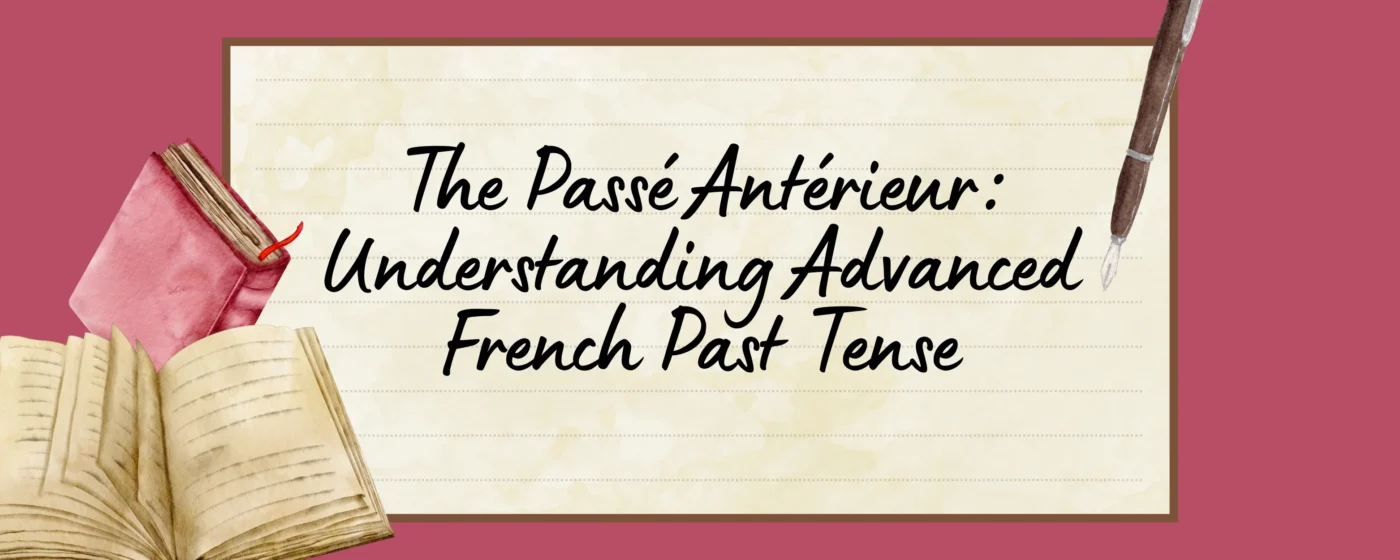The passé composé is a past tense in French that indicates completed actions. It’s formed using an auxiliary verb (either “avoir” or “être”) and the past participle of the main verb. On the other hand, the Imparfait is another past tense used to describe ongoing or repeated actions in the past. It’s formed by adding specific endings to the stem of the verb.
When to use imparfait
The imparfait tense in French is a past tense used to describe ongoing or habitual actions in the past. It’s often used to set the scene, provide background information, and express states of mind or feelings at a specific time in the past.
1. Describing ongoing actions:
This usage of the l’imparfait emphasizes actions that were ongoing or in progress when another event occurred.
Example: Je mangeais quand il est arrivé. (I was eating when he arrived.) Here, “mangeais” (was eating) indicates an action that was in progress when “il est arrivé” (he arrived), which is expressed in the passé composé tense.
2. Describing habitual actions:
L’imparfait is also used to describe actions that were habitual or repeated in the past, often in a context where no specific endpoint is mentioned.
Example: Quand j’étais jeune, je jouais au foot tous les jours. (When I was young, I used to play soccer every day.) In this sentence, “je jouais” (I used to play) indicates a habitual action that occurred repeatedly in the past without specifying individual instances.
3. Setting the scene and providing background information
L’imparfait is commonly used in storytelling to provide context and background details about the past.
Example: Il faisait beau. Les oiseaux chantaient. Tout était parfait. (The weather was beautiful. The birds were singing. Everything was perfect.) Here, “faisait” (was) and “chantaient” (were singing) create a vivid scene in the past, setting the mood and atmosphere.
4. Expressing feelings or states of mind:
L’imparfait can also be used to describe feelings, emotions, or mental states that were ongoing in the past.
Example: Elle était heureuse quand elle habitait en France.(She was happy when she lived in France.) In this sentence, “était” (was) describes a state of happiness that persisted during her time living in France.
When to use passé composé (perfect tense)
The passé composé is used to describe completed actions or events that occurred at a specific point in the past.It is often used for actions with a clear beginning and end, narrating a sequence of events, and emphasizing the result or outcome of an action.
1. Describing completed actions:
The passé composé is used to talk about actions that have been completed or happened at a specific time in the past.
Example: Hier, j’ai mangé au restaurant. (Yesterday, I ate at the restaurant.) Here, “ai mangé” (ate) indicates a completed action that occurred yesterday.
2. Narrating a sequence of events:
This tense is also used to narrate a series of completed actions or events that happened one after another.
Example: Je suis rentré chez moi, j’ai préparé le dîner, puis j’ai regardé la télé. (I came back home, prepared dinner, and then watched TV.) In this sentence, “suis rentré” (came back), “ai préparé” (prepared), and “ai regardé” (watched) are all actions completed in the past.
3. Emphasizing the result or outcome:
The passé composé is often used to highlight the result or consequence of an action that took place in the past.
Example: Elle a terminé son travail à l’heure. (She finished her work on time.) Here, “a terminé” (finished) emphasizes the successful completion of the work.
Clue Words for Imparfait
In French there are some words or expressions that often indicate the use of Imparfait. For example:
1. Tous les jours (every day):
This expression indicates a habitual action that occurred repeatedly in the past.
Example: Tous les jours, je me promenais dans le parc. (Every day, I used to walk in the park.)
2. Pendant que (while):
“Pendant que” introduces simultaneous actions, with one action being ongoing and another action occurring.
Example: Pendant que tu lisais, je faisais mes devoirs. (While you were reading, I was doing my homework.)
3. Souvent (often):
“Souvent” suggests a recurring action or frequency of occurrence in the past.
Example: Elle pleurait souvent quand elle était triste. (She used to cry often when she was sad.)
4. Quand (when):
“Quand” introduces actions that happened repeatedly or were ongoing at specific points in the past.
Example: Quand il pleuvait, nous jouions à l’intérieur. (When it was raining, we used to play indoors.)
Clue Words for Passé Composé
List of words or expressions that often indicate the use of Passé Composé. For example:
1. Hier (yesterday):
“Hier” specifies a specific time frame in the past, indicating a completed action or event.
Example: Hier, j’ai rencontré un vieil ami. (Yesterday, I met an old friend.)
2. Soudain (suddenly):
“Soudain” suggests an abrupt or sudden action that took place and was completed in the past.
Example: Soudain, il a commencé à pleuvoir très fort. (Suddenly, it started raining heavily.)
3. Tout à coup (all of a sudden):
Similar to “soudain,” “tout à coup” indicates a sudden action or change that occurred in the past.
Example: Tout à coup, elle a réalisé qu’elle avait oublié son sac. (All of a sudden, she realized she had forgotten her bag.)
4. La semaine dernière (last week):
“La semaine dernière” refers to a specific period in the past, indicating completed actions or events within that time frame.
Example: La semaine dernière, nous avons visité un musée. (Last week, we visited a museum.)
Certainly, here are more examples illustrating the use of both passé composé and l’imparfait, along with explanations for each:
Sentences/Examples with Passé Composé and Imparfait
Here are some examples with Passé Composé and Imparfait
1. “Pendant que je lisais, il est arrivé.”
Explanation: “Pendant que je lisais” indicates an ongoing action in the past (Imparfait), while “il est arrivé” describes a specific event that happened during that ongoing action (Passé Composé).
2. “Quand j’étais enfant, j’ai appris à nager.”
Explanation: “Quand j’étais enfant” sets the background as an ongoing state in the past (Imparfait), while “j’ai appris à nager” denotes a specific completed action that occurred during that time (Passé Composé).
3. “Tous les jours, je faisais du sport avant de travailler.”
Explanation: “Tous les jours” indicates a habitual action in the past (Imparfait), while “je faisais du sport” describes the ongoing habitual activity that was regularly done (Imparfait).
4. “Hier soir, nous avons mangé au restaurant.”
Explanation: “Hier soir” specifies a specific point in the past (Passé Composé), while “nous avons mangé au restaurant” denotes a completed action that took place at that time (Passé Composé).
5. “Quand il a commencé à pleuvoir, nous sommes rentrés chez nous.”
Explanation: “Quand il a commencé à pleuvoir” marks the beginning of a specific event (Passé Composé), while “nous sommes rentrés chez nous” describes the action that occurred after that specific event (Passé Composé).
Grammar Rules Got You Down?
La Forêt’s tutors simplify grammar so you can speak confidently and accurately.
Imparfait vs. passé composé
The distinction between l’imparfait and passé composé tenses in French reflects different aspects of past actions and events. Understanding when to use each tense depends on the context and the specific nature of the action being described.
Incomplete vs. Complete
Imparfait: Use it when describing actions without specifying when or if they ended.
Example: Il regardait la télévision. (He was watching television.)
Passé Composé: Use it when talking about actions that were completed.
Example: Il a regardé la télévision. (He watched television.)
Uncounted vs. Counted
Imparfait: Use it when talking about events that were frequent or happened many times without a definite count.
Example: Elle visitait Paris chaque été. (She used to visit Paris every summer.)
Passé Composé: Use it when speaking about actions that happened a specific number of times.
Example: Elle a visité Paris trois fois. (She visited Paris three times.)
Continuous vs. New
Imparfait: Expresses a continuous state of being or feeling.
Example: J’étais fatigué. (I was tired.)
Passé Composé: Highlights a change in that state or a specific point in time.
Example: Je suis devenu professeur. (I became a teacher.)
Background vs. Event
Imparfait: Describes continuing situations or emotions.
Example: Il faisait beau, et les oiseaux chantaient. (The weather was beautiful, and the birds were singing.)
Passé Composé: Introduces information about an event that has occurred.
Example: Il a commencé à pleuvoir. (It started raining.)
If you want to learn more about the difference between passé composé and l’imparfait, consider taking La Forêt online French lesson class for all level learners.
Conclusion
We have now reached the conclusion that passé composé indicates completed actions, while l’imparfait describes ongoing or habitual past actions. Mastering both tenses is crucial for effective communication in French, allowing nuanced expression of past events. Practice and exploration of these tenses are essential for fluency.
To learn more about French grammar, check out our blog page.
Frequently Asked Questions
Q: How do you use imparfait and passé composé in the same sentence?
Ans: To use l’imparfait and Le passé composé in the same sentence, L’imparfait sets the background or ongoing action, while passé composé interrupts with a completed action. For example: “Je lisais un livre quand le téléphone a sonné.” (I was reading a book when the phone rang.) The imparfait (“je lisais”) describes the on going action, and the passé composé (“a sonné”) describes the interruption.
Q: How do you identify L’imparfait?
Ans: You can identify the l’imparfait by looking for clues indicating ongoing or habitual actions in the past. Common indicators include expressions like “toujours” (always), “souvent” (often), “tous les jours” (every day), and “pendant que” (while). The l’imparfait is used to set the scene, describe background information, and express continuous states or repeated actions.
Q: Is age passé composé or imparfait?
Ans: Age is expressed using the l’imparfait in French because it describes a continuous state or condition in the past. For example, “Quand j’avais dix ans, je jouais au foot.” (When I was ten, I used to play soccer.) Here, “avais” (had) is in the l’imparfait to indicate the ongoing nature of being ten years old.





